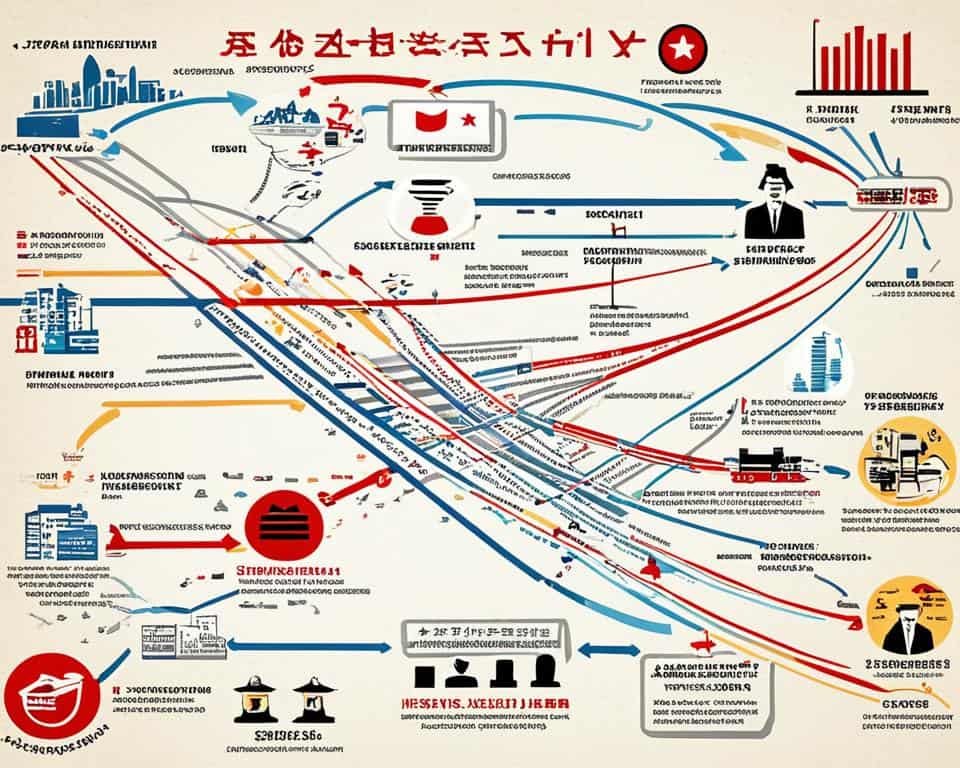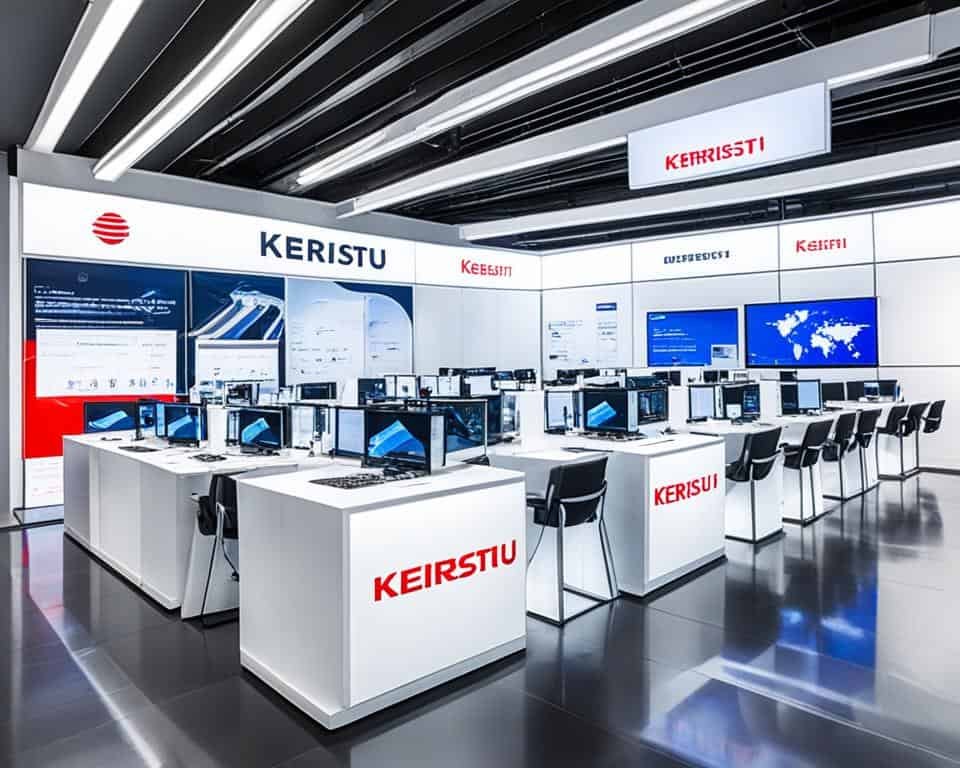
In Japan’s economy, keiretsu plays a key role, linking many interconnected companies. These are like strong business families, with a culture of sharing ownership. This system helps keep Japan’s business world steady.
By working closely with their suppliers and clients, the Holding company run smoothly. This teamwork boosts Japan’s economy’s strength and stability.
Key Takeaways
- Keiretsu networks are a defining feature of the Japanese corporate environment.
- Their role involves stabilizing and enriching the Japanese economic system.
- These conglomerates nurture long-term partnerships with suppliers and clients.
- Shared ownership among companies ensures a robust business ecosystem.
- The model underscores Japan’s distinctive approach to corporate governance.
- Interconnected companies within Holding companies bolster both efficiency and economic adaptability.
Understanding Keiretsu and Its Historical Roots
The Holding company is key in the Japanese business group scene today, tied deeply to its historical roots. It started after post-World War II, changing from the old zaibatsu system. This shift was a big move in Japan’s economic transformation.
The Evolution from Zaibatsu to Keiretsu
Originally, zaibatsu were big, family-run companies owning much of Japan’s economy. They went way back to the 1600s and helped a lot during the Industrial Revolution. But, after the U.S. took control post-World War II, they had to break up. This breakup set the scene for keiretsu to rise.
Defining the Structure
Groups work together but are not fully controlled like the old zaibatsu. There are two main types: horizontal and vertical. Horizontal keiretsu has different companies tied by owning shares in each other, usually around a bank. Vertical keiretsu groups are made up of companies in the same industry, like car makers and their parts suppliers.
Post-World War II Economic Transformation in Japan
The model really helped Japan grow after World War II. By having groups of companies support each other, Japan used its resources better and became more efficient. This teamwork made Japan a big player in the world economy.
Significance to the Japanese Corporate Governance
In Japan’s complex corporate world, Keiretsu networks are key. They link many companies together. These links help make better business plans and improve Japan’s economy. By creating strong connections among companies, they make operations smoother and stable.
Interlocking Directorates and Shareholding
Power comes from how its boards are connected. Directors from one company often sit on others’ boards. This setup is like a tight, secure net, which makes everything work better. When these companies also partly own each other, they’re less likely to face takeovers. This makes doing business more reliable.
Impact on Japan’s Corporate Efficiency and Stability
Holding company is all about working together. Companies easily share resources and ideas. This sharing helps businesses run well. It keeps Japan’s economy steady against sudden changes. This not only shows a smart way to run companies but also how unity can lead to success in the world.
The Operational Dynamics of Horizontal and Vertical Keiretsu
The operational dynamics of Holding companies, a key part of Japan’s corporate structure, show up in horizontal keiretsu and vertical keiretsu. These forms are vital for Japan’s businesses and economy. They work together through shared ownership and working as a team.
- Horizontal Keiretsu: It’s a group where companies own parts of each other. This builds a strong network of mutual help and safety. Usually, a leading bank is at the center, helping companies prevent takeovers and deal with changes in the market.
- Vertical Keiretsu: Vertical keiretsus are different. They are like a chain, with a main producer, then suppliers and sellers. This way of organizing helps to work better, save money, and move products faster through the chain.
Both Holding company types are deeply part of Japan’s economic system. They make a mix of working hard against each other but also helping out. Because they share owners, they stay strong financially. They also build long-lasting connections in business.
The togetherness in these networks makes companies strong against hard times. Both horizontal and vertical
Holding company
play a big role in how businesses work worldwide. They bridge new needs with old business traditions.
Major Players: The Constituents
In Japan’s economy, certain groups are key players. They are part of a network called keiretsu. The Big Six and some independent corporate groups have a big impact. They play important roles in Japan and around the world.

The Big Six of the Japanese Economy
The “Big Six” are six powerful Holding companies. They greatly affect Japan’s economy. The groups are Mitsui, Mitsubishi, Sumitomo, Fuyo, Sanwa, and DKB. They have roots in the old zaibatsu system.
Each Holding company has a central bank, a leading trading company, and makers of various products. They are very important in Japan’s economy.
Independent Corporate Groups and Their Roles
Some companies in Japan are not part of Holding companies but still make a big impact. Toyota, Hitachi, and Sony are among them. They are known for their unique mix of independence and cooperation.
This mix makes the Japanese economy strong and varied.
- Mitsubishi: Known for its diversified operations spanning finance, electronics, and automotive industries.
- Toyota: A global leader in automotive manufacturing that has efficiently integrated relationships to sustain innovation and production excellence.
- Sony: An independent giant in electronics and entertainment, leveraging Holding companies ties for strategic partnerships and market expansion.
Knowing about the Big Six, independent groups, and their roles helps see keiretsu’s importance. They are crucial for Japan’s economic well-being and progress.
Inter-Company Relationships
The system is built on strong inter-company relationships. These relationships make up a web of companies in Japan. They are tightly connected, not just in business but in culture too. This creates a network where companies help each other and work towards common goals.
At the heart of a group of companies is a web of transactional relationships. These are more than deals; they include sharing tech, swapping workers, and even starting businesses together. This helps them stay strong even when markets change or when facing outside competition.
- Shared technological advancements which strengthen the competitive edge.
- Financial interdependencies that ensure mutual economic support during downturns.
- Strategic alignments that endeavor long-term growth over short-term gains.
The close-knit inter-company relationships in a keiretsu do more than just build single companies’ power. They create a united front, able to handle tough times and spark new ideas. Understanding these ties is key to how closely linked companies in Japan keep thriving.
The Financial Pillars
Keiretsu’s world relies heavily on strong financial services. They are more than just tools; they are the base that helps these groups grow. With banking at the core, group of companies use a solid risk management plan. This helps them deal with debts and grow their businesses safely.
Banking and Financial Services Within the Model
Banking is vital in keiretsu’s structure. Banks do more than the usual. They help money flow between companies. This financial flow is key. It lets companies in the group grow quickly and smoothly.
- Interlocking shareholdings facilitated by banks
- Complex financial products tailored to support companies
- Strategic financial advice and planning services
Risk Management and Debt Dynamics in Keiretsu-affiliated Companies
Group of companies works hard to manage risks. This keeps them safe from financial shocks. They also control debts well. This is important as they make big investments. The right risk management lets companies stay strong, even when the market shakes.
- Assessment of investment risks within and across group of companies entities
- Debt management strategies to prevent unsustainable debt levels
- Regulatory compliance and monitoring to align with international financial standards
Efficiency and Limitations of the Keiretsu System
The Holding companies system is a key part of Japan’s economy. It mixes old and new ways, making businesses run well. Yet, it has problems when facing changes in the world market.
Supply Chain and Just-In-Time Inventory
The shines with its just-in-time inventory method. This saves money and cuts down on waste. It makes businesses quick to meet what the market needs.
Members of the work closely together. This helps them talk fast and make choices quickly. It makes their businesses very effective.
Challenges of Adapting to Global Market Changes
But, the group of companies can struggle with fast global shifts. It’s built on stability and long ties, which can slow down needed changes. The world’s quick tech growth and changing consumer tastes make being swift important, something the Holding companies can find tough.
- Market Challenges: Navigating international trade complexities and fluctuating economic conditions can be cumbersome for group of companies networks, which are traditionally geared towards internal market cohesion.
- Limitations: The same inter-company trust that bolsters internal supply chain efficiency can become a vulnerability, as it may slow down the adoption of innovative practices and hinder competitive edge in a fast-paced global market.
It’s key to see these issues clearly for the keiretsu’s future in global business.
Transformation in the Modern Japanese Economy
In the late 20th century, the Japanese business scene changed a lot. It was because of the shift in Holding companies organizations. They had to change because of tough economic times and more global competitors.
The scene was also shaped by technology advances. This made Holding companies rethink how they do things. They started to be more open, competitive, and focused on new ideas. Before, they would mostly work with each other, sharing stock. Now, they teamed up with new partners from around the world. This made their ways of working more flexible and ready to meet market needs.
- Expansion into global markets to mitigate domestic economic pressures
- Adoption of cutting-edge technologies to improve efficiency and productivity
- Strategic alliances with foreign companies to foster innovation and exchange expertise
This big change was not just something they had to do. It was a smart move to grab the chances opening up in global markets and tech. By dealing with trade and digital changes, they showed the world what great business looks like.

Now, keiretsu’s story is all about mixing old ways with new ones. The ongoing updates show these systems are ready for the coming global economy challenges.
Impact on International Business and Globalization
Keiretsu have a big influence on global markets. These networks show how connected the world is. They help set trade rules and grow businesses around the globe.
Influence on Global Supply Chains
Keiretsu make global supply chains work better. Their careful planning and partnerships help companies run smoothly. This means products and services can reach everywhere without big delays.
Japanese Brands and Global Recognition
Brands like Nintendo, Sony, and Toyota are now world-famous, not just in Japan. They stand out for their quality and new ideas thanks to networks. These brands are a symbol of Japan’s precise and dependable work, and they show the power of keiretsu worldwide.
Keiretsu have a deep role in global business. They show how important and key these big business groups are worldwide. They show Japan’s flexible way of doing business around the globe.
Managing Crisis: Japanese Economic Downturns
During tough times in the Japanese economy, like the asset bubble burst and 1990s stagnation, keiretsu showed their strength. These groups are deeply connected in Japan’s economy. They proved they could handle crises well by being flexible and smart.
Keiretsu works on cooperation and shared goals. Companies help each other during hard times by sharing resources. This way, they can stay strong even when the economy is not doing well.
- Collective Financing: With joint funding, companies could get money they needed without going to the bank. This helped them all stay strong together.
- Adaptation to Market Shifts: Keiretsu changed their plans when the economy changed. They found new markets and improved how they made things. This helped them weather the crisis.
- Maintaining Core Values: But they always kept their main values, like being loyal and working together. This made sure their networks stayed stable and strong.
Keiretsu’s success in hard times highlights the value of their close-knit structures. They play a big role in keeping Japan’s economy going. Their mix of old and new business methods shows they can stay strong and smart no matter the challenge.
Future Prospects: The Evolution of Keiretsu
As Japan moves through a global market and new technology, structures are changing a lot. These business groups must mix old ways with new strategies for future success.
Keiretsu’s evolution is key for Japan’s economy to grow. They are adopting different plans to change how they work and achieve goals. Let’s look at a few ways keiretsu might change:
- Integration with Global Business Practices: Might blend more with global business norms to stay competitive worldwide. This could help them adapt better on a global scale.
- Technological Innovation: Being up-to-date with the latest tech could make keiretsu and their companies more efficient. This might help in growing the economy.
- Sustainability Focus: There might be more investment in eco-friendly business practices and tech by keiretsu. This shift would match the world’s green movement and what customers want.
Future changes for keiretsu are filled with hope. But, they need to tackle tough issues to evolve. They must keep their core values while bringing in new ideas. This way, these traditional Japanese businesses can stay strong in a fast-paced world.
Conclusion
The Japanese economy is like a rich tapestry. It’s shaped by the strong system. This system connects companies closely.
Keiretsu has a big role. It makes Japan strong in the world. Thanks to it, companies work together for success. Their strong bonds lead to steady growth.
In today’s fast-changing world, corporate evolution is key. But keiretsu is adapting well. It stays strong through challenges and changes. Keiretsu shows a mix of old and new ways, keeping their values strong.
Keiretsu keeps Japan’s economy strong. It also affects the whole world’s economy. By working together, these companies show that partnerships can lead to growth for all. They prove that staying true to their values, while changing, is vital for success today.
FAQ
What are the future prospects for keiretsu considering economic growth and corporate adaptation?
Keiretsu plans to mix its old and new ways to stay strong. They want to keep what’s good from the past and use new ways to be better. This makes them ready for the fast-growing world market.
How did keiretsu respond to economic downturns in Japan?
In tough times, keiretsu stands strong by changing how they spend money, thinking of new business, and sticking together. This keeps them making good choices in hard times.
What impact does keiretsu have on international business and globalization?
Keiretsu makes Japan’s brands big all over by working with others worldwide. Their smart sharing and going global show how modern they are in business around the world.
How have keiretsu conglomerates adapted to the modern Japanese economy?
To stay strong, keiretsu groups are now more focused on the market. They’re using new tech, improving how they work, and sometimes loosening their old connections to do better.
What are the primary challenges keiretsu faces in adapting to global market changes?
Keiretsu is very strong together, but it can be slow in a fast-changing world. It tries to keep being steady while changing fast enough to beat others abroad.
How does the keiretsu system affect the efficiency of supply chains?
Keiretsu makes supply chains better through working together in shipping, sharing business data, and using new ways like just-in-time stock. Their teamwork cuts waste and makes more goods in less time.
What are the financial pillars of a keiretsu?
Keiretsu relies on special banks and insurers within the groups. They help with shared ownership and offer needed money help. This keeps the whole system running well.
How do inter-company relationships work within a keiretsu?
Companies in a keiretsu team up by sharing stocks, through special deals, and by agreeing to buy from each other for a long time. This makes them support each other in money and new ideas, building a deep trust.
What is the role of independent corporate groups in the keiretsu system?
Companies like Toyota, Hitachi, and Sony partly work alone, but also join with keiretsu firms. This mix lets them be strong and change when needed to grow their business.
Who are the Big Six in the Japanese economy?
The Big Six are the top keiretsu groups in Japan. Each is led by a bank, a trading company, and many makers. They are very important in Japan’s business and economy.
What is the difference between horizontal and vertical keiretsu?
Horizontal keiretsu connects big companies from many fields through a bank. This makes buying and selling easier. Vertical keiretsu, however, links companies in one industry together. They work as a team from making to selling goods.
How do keiretsu influence corporate governance and efficiency in Japan?
Keiretsu makes sure companies have the same goals by sharing ownership and leadership. This makes them work together better over a long time. It stops companies from fighting each other and helps avoid takeovers.
What distinguishes the keiretsu structure from other types of business organizations?
Keiretsu stands out by how companies work together in different ways. They share owners, leaders, and have strong ties. This helps them work well together for a long time, making Japan’s marketplace steady.
How did keiretsu evolve from zaibatsu?
After World War II, the U.S. broke up the zaibatsu to end their control of Japan’s economy. Japan then set up keiretsu, which connects companies through ownership and alliances. This new system helped businesses work together.
What is Keiretsu and how is it significant to the Japanese economy?
Keiretsu is a network of companies in Japan tied by ownership and partnerships. It shapes the business world and helps keep the economy strong. It does this by promoting good relationships between suppliers and clients.
